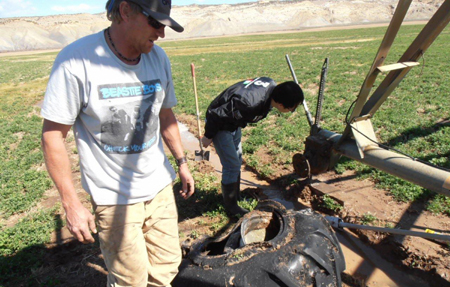
Export licenses rise
|
 |
|
Ranch manager Frank Biggs (left), and Roger Qiao, an employee of Lu Tian Yuan in Beijing, check the farm machinery. |
The ranch is adjacent to the Dinosaur National Monument, which straddles the Utah-Colorado border and is named for the giant reptiles that once roamed what are now desert canyons. Hard by the Green River - Zhang indicated that as the owner he has water rights - the ranch hosts some of the richest soil for growing alfalfa and grain.
In the United States, the world's biggest producer, more than 99 percent of all alfalfa hay bound for export is grown in seven Western states, including Utah, according to the National Alfalfa and Forage Alliance.
The number of exporters licensed by the US Department of Agriculture to ship to China has increased to more than 70 from 17 in recent years, according to Simon Shao, the executive Zhang hired to oversee the ranch. Both Zhang and Shao visit Escalante about once a month, sometimes more frequently during the harvest season, which runs from March to October.
Zhang, a native of the Inner Mongolia autonomous region, has been working in agriculture since he graduated from Shandong University with a degree in biology in the late 1980s. He has been involved in exporting alfalfa hay since 2007, buying the crop from licensed US processors and shipping it to China.
Last year Zhang shipped about 50,000 tons to China in the form of double-compressed bales, compared with 5,000 when he started his business five years ago.
"It's hard to believe that it actually may cost less to ship from Long Beach, California, to cities in China than to ship between cities in China," he said.
Zhang's company, Lu Tian Yuan, is based in Beijing's Changping district. It employs roughly 300 people in three factories in the capital and in Inner Mongolia and is one of the oldest and biggest suppliers of alfalfa pellets in China. Its clients include well-known Chinese dairy brands, according to Zhang, although he declined to name them, and customers in Japan and South Korea.
Despite the increasing need for alfalfa hay to feed dairy cows, the rapidly decreasing quantity of arable land in China has affected production of the crop domestically, said Zhang.
"It's true that not all dairy producers can afford high-quality alfalfa, but paying a bit more can increase the output and quality of dairy products, which will eventually create sales value for the producers," Shao said.
Increasing the proportion of alfalfa to about half of a cow's diet is a good way to boost protein levels in milk to the international standard of 3.2 percent (compared with China's current 2.8 percent) or higher, said Lu Xinshi, a professor at Beijing Forestry University. "Alfalfa in the diet can also help extend a cow's milking life and increase the quality of the dairies," Lu said.
As owner of the Utah ranch, Zhang is legally an alfalfa hay provider and can conduct business with processors in the US directly, making his business sustainable, as he put it.
"We have seen the price increase from about $200 a ton two years ago to more than $400 a ton last year," said Shao. "It looks good and may still be on the rise."
To supply its growing dairy industry, China bought 96,000 tons of alfalfa hay from the US in the first quarter of this year, more than half the total in 2011 and 200 percent higher than in the first three months of last year, according to the Livestock Marketing Information Center in Denver.
"China's buying patterns will likely be highly dependent on their domestic forage production. The faster forage production meets demand in China, the less China will need to source forage from the US and other countries," said Katelyn McCullock, a dairy and forage economist with the center, which connects USDA economists, industry representatives and university agricultural extension agents.
The top export destinations for US alfalfa include Japan, the biggest buyer, and South Korea. Meanwhile, China and the United Arab Emirates have become fast-growing markets for the crop in recent years, according to the USDA.


 Washington to remain focused on Asia-Pacific
Washington to remain focused on Asia-Pacific RQFII target blue chips amid bear market
RQFII target blue chips amid bear market Australian recall for top two exporters
Australian recall for top two exporters China fears new car restrictions
China fears new car restrictions